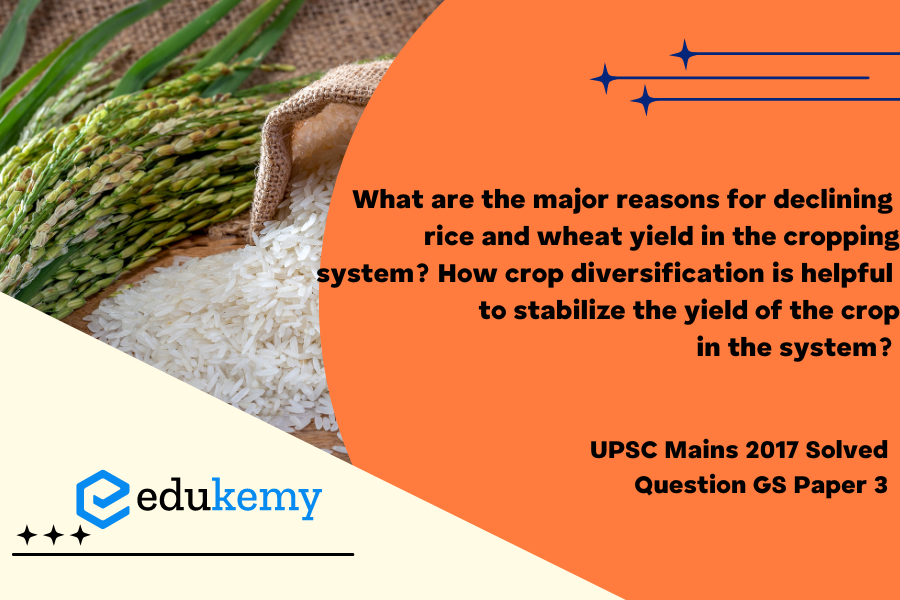The declining yield of rice and wheat in cropping systems has become a pressing concern in agricultural landscapes globally, prompting a need for a thorough understanding of the factors contributing to this decline. Several major reasons contribute to the diminishing yields, including soil degradation, pest infestations, climate change-induced stresses, and unsustainable agricultural practices. Soil degradation, often resulting from excessive use of chemical fertilizers and poor land management, adversely affects the fertility of the soil, impacting the growth and productivity of rice and wheat crops. Additionally, the increasing prevalence of pests and diseases poses a significant threat to these staple crops, leading to yield losses and economic burdens on farmers. Climate change further exacerbates the problem, with unpredictable weather patterns, extreme temperatures, and altered precipitation affecting the growth cycles of these crops.
Tag: Major crops, cropping patterns in various parts of the country.
Contents
Decoding the Question:
- In the Intro, try to define the cropping system and highlight the declining trend of rice and wheat crop yields.
- In Body,
- Discuss the reasons for the declining trend of rice and wheat yield.
- Discuss the merits of crop diversification.
- Try to conclude by linking with the Sustainable Development Goals.
Answer:
A cropping system is the type and sequence of crops grown and practices used for growing them. In India rice and wheat is the dominant cropping system. Rice-wheat cropping system is labour, water, capital and energy-intensive, and becomes less profitable as availability of these resources diminishes.
According to the Economic Survey 2015-16 yields of major crops like paddy and wheat are declining:
- In wheat, India’s average yield in 2013 of 3075 kg/ha is lower than the world average of 3257 kg/ha.
- In paddy production, all Indian states have yields below that of China and most states have yields below that of Bangladesh. India’s best state, Punjab, has paddy yield close to 6000 kg/ha whereas China’s yield is 6709 kg/ha.

The reasons behind the declining yields of rice and wheat are:
- Decline in Soil fertility: Due to continuous irrigation and use of excessive flood irrigation, soil in the rice-wheat cropping system has become saline. It has resulted in a decrease in crop yield.
- Climate change: According to studies, climate change has a negative effect on major crops such as wheat, rice and maize. Increase in annual temperature range has also affected the crop yield of rice and wheat.
- Increased input cost: High rate of infestation with weeds and pests along with contamination of ground water have resulted into high cost of input for cultivation of rice and wheat.
- Change in water availability: Due to excessive use of ground water and consequent depletion of groundwater resources, water availability has declined. This has resulted in a decline in crop yield.
- Crop Diversification: Due to Minimum Support Price farmers are increasingly producing wheat and rice this made farmers not give emphasis on crop diversification. Poor practice of crop diversification is largely responsible for declining soil nutrients and productivity.
Crop diversification helps in the following manner:
- Arrest Declining Groundwater: Declining groundwater can be stopped by crop diversification. Growing crops according to the climatic conditions and available water resources will definitely help in arresting declining groundwater sources.
- Increase Soil Nutrients: Crops such as pulses, coarse grains are known as hardy crops as they can grow in less nutrient and less water available areas. These crops even help in fixing nitrogen in soil which is one of the very essential components for crops growth.
- Nutritional Security: Dependent on wheat and rice will create a challenge of nutritional security. India has one of the largest populations with malnutrition and micronutrients deficiency. Crop diversification will help in solving these issues.
- Soil Biodiversity: Crop diversity helps in maintaining soil biodiversity. This soil biodiversity is very essential for crops survival as they keep on recycling soil nutrients.
- Increasing Tolerance: With crop diversification the crops in drier areas can be clubbed with the less water consuming crops like millets.
The government of India has launched a crop diversification scheme in the original green revolution areas of Punjab, Haryana and Western Uttar Pradesh. Under Crop Diversification Programme assistance is provided to states for conducting cluster demonstrations on alternate crops, promotion of water saving technologies, distribution of farm machinery, and awareness through training.
In case you still have your doubts, contact us on 9811333901.
For UPSC Prelims Resources, Click here
For Daily Updates and Study Material:
Join our Telegram Channel – Edukemy for IAS
- 1. Learn through Videos – here
- 2. Be Exam Ready by Practicing Daily MCQs – here
- 3. Daily Newsletter – Get all your Current Affairs Covered – here
- 4. Mains Answer Writing Practice – here


